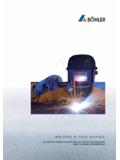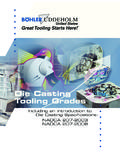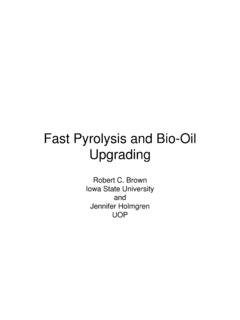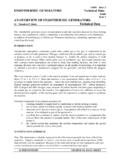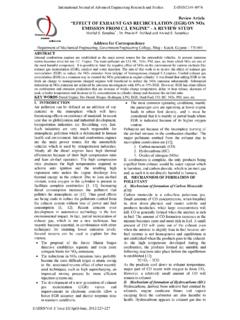Transcription of CALDIE eng R1710 klar - bucorp.com
1 UddeholmCaldie CALDIE eng R1710 12017-10-27 13:102 Uddeholm CaldieThis information is based on our present state of knowledge and is intended to provide general notes on our products and their uses. It should not therefore be construed as a warranty of specific properties of the products described or a warranty for fitness for a particular according to EU Directive 1999/45/ECFor further information see our Material Safety Data Sheets .Edition 15, UDDEHOLMS ABNo part of this publication may be reproduced or transmitted for commercial purposes without permission of the copyright holder. CALDIE eng R1710 22017-10-27 13:103 Uddeholm CladieUddeholm CALDIE CHANGING TOOLING ENVIRONMENTNew and more demanding work materials are continuously imple-mented in the industry. As a consequence of the introduction of AHSS, Advanced High Strength Steel, the forming tools have to resist higher stress levels and withstand more adhesive and abrasive wear.
2 Many times the tool has to be coated in order to fulfil production require-ments, the tool material also has to be a good substrate material for different type of surface PROBLEM SOLVERU ddeholm CALDIE is the first ESR-grade and developed with main focus on severe cold work excellent combination of compressive strength, wear resistance and chipping/cracking resistance has been achieved by a well balanced chemis-try of matrix type and a clean and homogeneous microstructure. Appropri-ate heat treatment properties and high fatigue strength make Uddeholm CALDIE also to a perfect substrate material for surface coatingsA VERSATILE TOOL STEELThe unique properties profile of Uddeholm CALDIE include very good weldability, castability, through hardening properties, machinability and grindability. This means that Uddeholm CALDIE provides many differ-ent options for eco-nomical toolmaking, tool using and maintenance, especially for larger forming tools.
3 CALDIE eng R1710 32017-10-27 13:104 Uddeholm CaldieCOMPRESSIVE STRENGTHA pproximately compressive strength vs. hardness is shown in the table below. Hardness Compressive yield strength, HRC Rc0,2 (MPa) 58 2230 60 2350 61 2430 GENERALU ddeholm CALDIE is a chromium-molybdenum-vanadium alloyed tool steel which is charac-terized by: very good chipping and cracking resistance good wear resistance high hardness (>60 HRC) after high tem- perature tempering good dimensional stability in heat treatment and in service excellent through-hardening properties good machinability and grindability excellent polishability good surface treatment properties good resistance to tempering back very good WEDM propertiesTypical C Si Mn Cr Mo V analysis % specification NoneDeliverycondition Soft annealed to max.
4 215 HBColour code White/greyAPPLICATIONSU ddeholm CALDIE is suitable for short to medium run tooling where chipping and/or cracking are the predominant failure mecha-nisms and where a high compressive strength (hardness above 60 HRC) is necessary. This makes Uddeholm CALDIE an excellent problem solver for severe cold work applications where the combination of a hardness above 60 HRC and a high cracking resistance is of utmost importance as in the blanking and forming of ultra high strength steel CALDIE is also very suitable as a substrate steel for applications where surface coatings are desirable or WORK APPLICATIONS Blanking applications where high ductility and toughness are needed to prevent chipping/cracking Cold forging and forming operations where a high compressive strength combined with good resistance to chipping/cracking are necessary Machine knives Thread rolling dies Substrate for surface coatingsUDDEHOLM COMPONENT BUSINESS APPLICATIONSU ddeholm CALDIE can be used in engineering applications where high
5 Compressive strength has to be combined with high ductility/tough-ness. Knives for fragmentation of plastics and metals and roll forming rolls are good properties below are representative of samples which have been taken from the centre of bars with dimensions 203 x 80 mm and 102 mm. Unless otherwise indicated, all specimens have been hardened at 1025 C (1875 C), gas quenched in a vacuum furnace and tempered twice at 525 C (975 F) for two hours to 60 61 PROPERTIESH ardened and tempered to 60 61 20 C 200 C 400 C (68 F) (390 F) (750 F)Density, kg/m3 7 820 lbs/in3 Modulus of elasticityMPa 213 000 192 000 180 000psi x 106 x 106 x 106 Coefficient of thermal expansionper C from 20 C x 10 6 x 10 6per F from 68 F x 10 6 x 10 6 Thermal conductivityW/m C 24 28 Btu in/(ft2h F) 174 195 Specific heatJ/kg C 460 Btu/lb F eng R1710 42017-10-27 13.
6 105 Uddeholm CladieCHIPPING RESISTANCER elative chipping resistance for Uddeholm CALDIE , AISI A2 and AISI D2 is shown CALDIE AISI A2 AISI D2 HEAT TREATMENTSOFT ANNEALINGP rotect the steel and heat through to 820 C (1510 F wait for equalization of the tempera-ture (equalization time related to the size of the tool). Then cool in the furnace at 10 C (20 F) per hour to 650 C (1200 F), then freely in air to room RELIEVINGA fter rough machining the residual stresses should be relieved by tempering at 650 C (1200 F), holding time 2 hours. Cool slowly in the furnace to 500 C (930 F), then freely in air to room temperature: 600 650 C (1110 1200 F) and 850 900 C (1560 1650 F). In case of bigger dimensions (>150 mm cross section) a third preheating step at 930 C (1700 F) is temperature: 1000 1050 C (1830 1920 F), normally 1020 C (1870 F), in case of bigger dimensions (>150 mm cross section) 1000 C (1830 F).)
7 Holding time: 30 minutes after the tool is heated : Holding time = time at hardening temperature after the tool is fully heated through. A holding time of less than recom-mended time will result in loss of tool should be protected against decar-burization and oxidation during information can be found in the Udde-holm brochure Heat treatment of tool steels .CCT-GRAPHA ustenitizing temperature 1025 C (1880 F). Holding time 30 cooling ofbars, mm1101001 00010 000100 000 Seconds1101001 C 10 800 50 (sec)TAustenitizing tem. 1025 C (1880 F)Holding time 30 minutes2345678 MsMartensitePearlite1 Bainite123456788248138038037926905254642 140280103015962325521513850 Carbides= 870 C (1600 F)A1cf= 805 C (1480 F)A1csCALDIE eng R1710 52017-10-27 13:106 Uddeholm CaldieQUENCHING MEDIA Vacuum (high speed gas with sufficient overpressure minimum 2 bar) Martempering bath or fluidized bed at approx.
8 200 550 C (390 1020 F) Forced air/gasNote: Temper the tool as soon as its temperature reaches 50 70 C (120 160 F).In order to obtain the optimum properties for the tool, the cooling rate should be as fast as possible with regards to acceptable slow quench rate will result in loss of hardness compared with the given tempering should be followed by forced air cooling if wall thickness is exceeding 50 mm (2 ).TEMPERINGC hoose the tempering temperature according to the hardness required by reference to the tempering graph below. Temper at least twice with intermediate cooling to room tempera-ture. For highest dimensional stability and The tempering curves are obtained after heat treatment of samples with a size of 15 x 15 x 40 mm, cooling in forced air (T800 500 = 300 sec.). Lower hardness can be expected after heat treatment of tools and dies due to factors like actual tool size and heat treatment Tempering temperaturetemp.
9 540 C 550 C 560 C1000 C* (1830 F*) 57 59 HRC 56 58 HRC 54 56 HRC1020 C(1870 F) 58 60 HRC 57 59 HRC 55 57 HRC1050 C (1920 F) 59 61 HRC 58 60 HRC 56 58 HRCFor high dimensional stability min. 540 C (1000 F) and 3 x 1 h should be used.*Hardening temp. 1000 C (1830 F) should be used for cross sections >150 mm (6" thick). TEMPERING GRAPHTEMPERING TABLE 200 300 400 500 600 C 390 570 750 930 1110 F Tempering temperatureRetained austenite %40353025201510 564605652484440 Hardness, HRCA ustenitizing temperature 1020 C (1870 F)Austenitizing temperature 1050 C (1920 F)Retained austenite 1020 C (1870 F)Retained austenite 1050 C (1920 F)ductility, a minimum temperature of 540 C (1000 F) and three tempers is strongly at a lower temperature than 540 C (1000 F)
10 May increase the hardness and compressive strength to some extent but also impair cracking resistance and dimen-sional stability. However, if lowering the tempering temperature, do not temper below 520 C (970 F). When tempering twice the minimum holding time at temperature is 2 hours. When tempering three times the minimum holding time is 1 eng R1710 62017-10-27 13:107 Uddeholm CladieGrain sizeASTM10 9 8 7 6 5 4 3 2 1 DIMENSIONAL CHANGESThe dimensional changes have been measured after austenitizing at 1000 C (1830 F)/30 min. and 1020 C (1870 F)/30 min. followed by gas quenching in N2 at a cooling rate of C/s between 800 500 C (1470 930 F) in a cold chamber vacuum furnace. Specimen size: 100 x 100 x 100 mm ( " x " x "). Values for all directions are within the marked changes (%)0,180,160,140,120,100,080,060,040,02 0-0,02-0,04-0,06-0,08 500 520 540 560 580 600 C 932 968 1004 1040 1076 1112 F Tempering temperature 2 x 2hHARDNESS, GRAIN SIZE AND RETAINED AUSTENITE AS A FUNCTION OF AUSTENITIZING TEMPERATURE 990 1000 1010 1020 1030 1040 1050 1060 C1814 1832 1850 1868 1886 1904 1922 1940 F Austenitizing temperature, 30 minutesHardness, HRC666463626160 Retained austenite % 5040302010 Retained austeniteHardnessGrain size1020 C (1870 F)1000 C (1830 F)SURFACE TREATMENTS Tool steel may be given a surface treatment in order to reduce friction and increase wear resistance.



